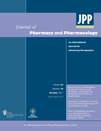Flavonoids in Scutellaria immaculata and S. ramosissima (Lamiaceae) and their biological activity
Abstract
Objectives The aim of this study was to investigate the flavonoid composition of Scutellaria immaculata and S. ramosissima (Lamiaceae) and the in-vitro biological activity of their extracts and flavonoids.
Methods The flavonoid composition of S. immaculata (Si) and S. ramosissima (Sr) were analysed using LC-MS. Antimicrobial activity was studied in vitro against a range of bacteria and fungi using diffusion and microdilution methods. Anti-trypanosomal and cell proliferation inhibitory activity of the extracts and flavonoids was assessed using MTT. The antioxidant activity of the flavonoids and extracts were evaluated using DPPH* test.
Key findings LC-MS investigation of Si and Sr plants allowed the identification, for the first time, of an additional 9 and 16 flavonoids, respectively. The methanol, chloroform and water extracts from these plants and six flavonoids (scutellarin, chrysin, apigenin, apigenin-7-O-glucoside, cynaroside and pinocembrine) exhibited significant inhibition of cell growth against HeLa, HepG-2 and MCF-7 cells. The chloroform extract of Sr showed potent cytotoxic effects with IC50 (drug concentration which resulted in a 50% reduction in cell viability) values of 9.25 ± 1.07 µg/ml, 12.83 ± 1.49 µg/ml and 17.29 ± 1.27 µg/ml, respectively. The highest anti-trypanosomal effect against T. b. brucei was shown by the chloroform extract of Sr with an IC50 (drug concentration which resulted in a 50% inhibition of the biological activity) of 61 µg/ml. The pure flavonoids showed an IC50 range between 3 and 29 µm, with cynaroside as the most active compound with an IC50 value of 3.961 ± 0.133 µm. The chloroform extract of Sr has potent antimicrobial activity against Streptococcus pyogenes (minimum inhibitory concentration, MIC = 0.03 mg/ml). Pinocembrine exhibited a strong activity against the all bacteria except Escherichia coli and yeasts. Water extracts of Sr and Si exhibited potent antioxidant activity with IC50 values of 5.62 ± 0.51 µg/ml and 3.48 ± 0.02 µg/ml, respectively. Scutellarin exerted stronger antioxidant activity than other flavonoids.
Conclusions This is the first study reporting an in-vitro biological investigation for Si and Sr. Especially the chloroform extract of Sr showed potent anticancer and antimicrobial activity. Cynaroside had a highly selective and strong cytotoxicity against T. b. brucei while showing only mild effects against cancer cells.




